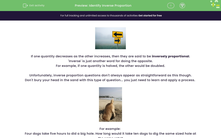.jpg)
If one quantity decreases as the other increases, then they are said to be inversely proportional.
'Inverse' is just another word for doing the opposite.
For example, if one quantity is halved, the other would be doubled.
Unfortunately, inverse proportion questions don't always appear as straightforward as this though.
Don't bury your head in the sand with this type of question... you just need to learn and apply a process.

For example:
Four dogs take five hours to did a big hole. How long would it take ten dogs to dig the same sized hole at the same rate?
Let's make a table to summarise what we know and what we want to find out:
| 4 dogs |  |
Take 5 hours |
| 1 dog | 5 × 4 | 20 hours |
| 10 dogs | 20 ÷ 10 | 2 hours |
So we used what we know to find the corresponding amount for a single unit (in this case 'one dog'), then applied this to the new total.
Let's try another problem to practise this process more.

For example:
It takes 5 bakers, 4 hours to bake 125 cakes. How long would it take 8 bakers to make 200 cakes if they all work at the same rate?
| 5 bakers |  |
Take 4 hours |
| 1 baker | 4 × 5 | 20 hours |
| 8 bakers | 20 ÷ 8 | 2.5 hours (for 125 cakes) |
| 1 cake | 2.5 ÷ 125 | 0.02 hours |
| 200 cakes | 0.02 × 100 | 4 hours |
Don't you think it is unfair that you always have to do that bit extra before you can get some cake?
Now let's put this process into action!
In this activity, we will explore relationships which are inversely proportional, using the information provided to find the value of a single unit, then applying this information to a new total to solve a real-world problem.








